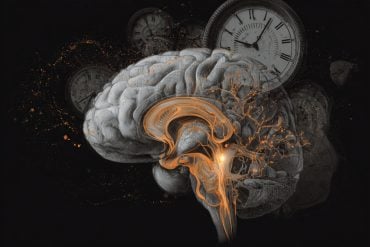Summary: Mouse study reveals the presence of the Baml1 gene in the striatum has a sexually dimorphic effect on alcohol consumption. Male mice without the protein consumed more alcohol than those who did, while the reverse was true for females.
Source: Concordia University
It’s a commonly heard question after New Year’s [celebrations]: “Why do we drink the way we do?” A group of researchers has found that at least some of it has to do with a particular protein in the part of the forebrain that regulates, among other things, decision-making and reward perception.
That’s the focus of an article published recently in the Nature journal Communications Biology. In it, the researchers illustrate that the presence of the Bmal1 gene in the striatum affects alcohol consumption in both male and female mice—but in a sexually dimorphic manner. Male mice without the protein consumed more alcohol than those that had it, while female mice without the protein consumed less than females with it.
Bmal1 is also an integral element in the suprachiasmatic nucleus, the master circadian clock found in all mammals that regulates the sleep-wake cycle. Previous association analyses of clock genes revealed a potential role for Bmal1 in alcohol-drinking behavior. Expanding on this—and given evidence of sex differences in alcohol consumption and in some functions of clock genes—the researchers hypothesized that Bmal1 may affect alcohol intake in a sex-dependent manner.
The study was led by Nuria de Zavalia, a research associate and lab manager at the Concordia University Center for Studies in Behavioral Neurobiology and supervised by Shimon Amir, a professor of psychology and Distinguished University Research Professor. The co-authors are research associate Konrad Schoettner, undergraduate student Jory Goldsmith, research assistant Pavel Solis, alumna Sarah Ferraro and research assistant Gabrielle Parent.
Risk in females, protection in males
The researchers created two lines of mice, using molecular biology methods to delete or “knock out” the Bmal1 gene from the striatum’s medium spiny neurons in one of them. The gene remained present in other parts of the body, since it plays a critical role in the circadian clock. The other line was used as a control.
Males who had the Bmal1 gene deleted from the striatum were found to consume more alcohol than the ones that did not have it deleted, while in the females, the results were the opposite: Those without Bmal1 consumed less alcohol than those that had it. (Normally, female rodents tend to consume more alcohol per body weight than males.)

“The main conclusion we can draw from this is that in females, Bmal1 in the striatum confers risk, since they consume more alcohol when the gene is present,” Amir says. “In males, the gene is protective, as they drink less alcohol. The sex differences you see in normal mice are eliminated when the gene is taken out of the striatum.”
Amir notes that neither the sugar consumption nor circadian rhythms is affected by the deletion of the gene.
“It seems that striatal Bmal1 plays a causal role in the control of alcohol consumption and makes an important contribution to sex differences in alcohol intake,” he explains.
A basis for sex-based treatment?
The researchers believe this discovery can help in treating addiction in humans. For instance, while women report lower alcohol use and dependency than men, they suffer more adverse consequences of alcohol use and dependency.
“So far, the limited biological and pharmacological treatments for alcohol dependence don’t distinguish between males and females, even though there are major differences in alcohol drinking behavior and addiction between the sexes,” he says. “By discovering sexually dimorphic mechanisms, addiction treatment specialists could ultimately use this knowledge to develop sex-based treatment.”
About this genetics research news
Author: Patrick Lejtenyi
Source: Concordia University
Contact: Patrick Lejtenyi – Concordia University
Image: The image is in the public domain
Original Research: Open access.
“Bmal1 in the striatum influences alcohol intake in a sexually dimorphic manner” by Nuria de Zavalia et al. Communications Biology
Abstract
Bmal1 in the striatum influences alcohol intake in a sexually dimorphic manner
Alcohol consumption has been strongly associated with circadian clock gene expression in mammals. Analysis of clock genes revealed a potential role of Bmal1 in the control of alcohol drinking behavior. However, a causal role of Bmal1 and neural pathways through which it may influence alcohol intake have not yet been established.
Here we show that selective ablation of Bmal1 (Cre/loxP system) from medium spiny neurons of the striatum induces sexual dimorphic alterations in alcohol consumption in mice, resulting in augmentation of voluntary alcohol intake in males and repression of intake in females. Per2mRNA expression, quantified by qPCR, decreases in the striatum after the deletion of Bmal1.
To address the possibility that the effect of striatal Bmal1 deletion on alcohol intake and preference involves changes in the local expression of Per2, voluntary alcohol intake (two-bottle, free-choice paradigm) was studied in mice with a selective ablation of Per2 from medium spiny neurons of the striatum. Striatal ablation of Per2 increases voluntary alcohol intake in males but has no effect in females.
Striatal Bmal1 and Per2 expression thus may contribute to the propensity to consume alcohol in a sex -specific manner in mice.






